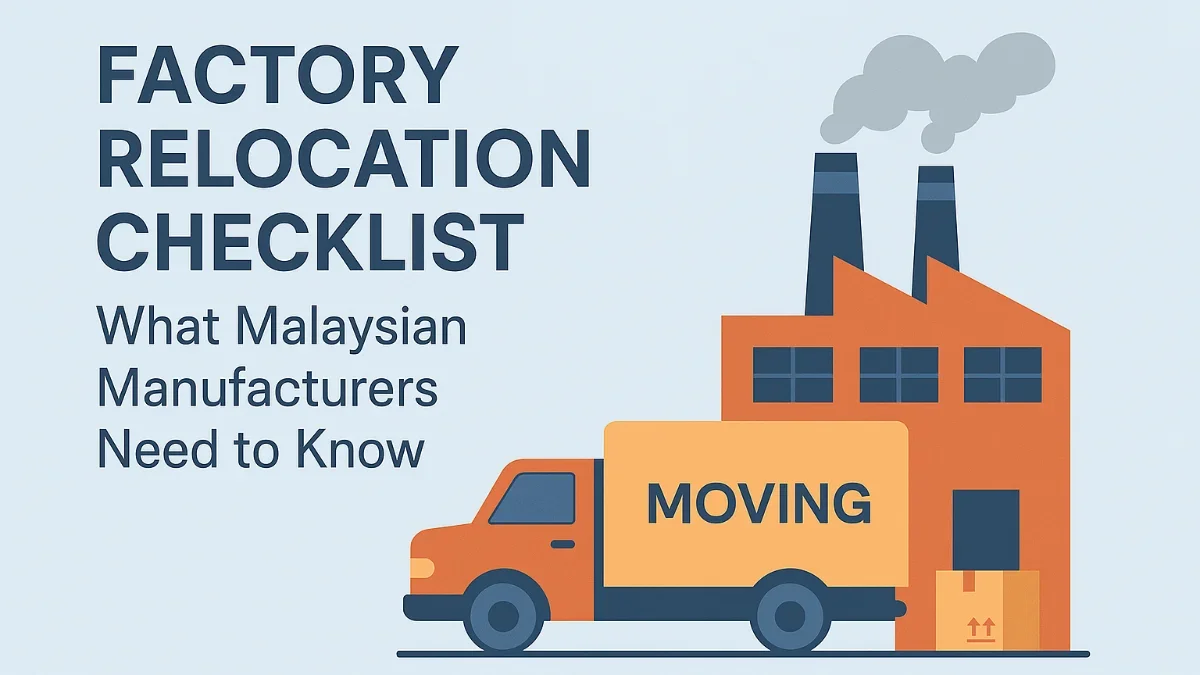Planning to move your factory in 2025? This comprehensive checklist covers everything Malaysian manufacturers need to ensure a smooth and successful relocation—from site selection to legal approvals and machinery transfer.
Factory Relocation Checklist: What Malaysian Manufacturers Need to Know
Helpful for Companies Moving to New Sites in 2025
Relocating a factory is a major milestone for any manufacturing business. Whether you're scaling operations, upgrading facilities, or moving closer to logistics hubs, a well-planned factory relocation can boost efficiency, reduce costs, and future-proof your business.
In this guide, we provide a practical, step-by-step checklist for Malaysian manufacturers planning to relocate their factory in 2025 — covering legal, operational, and technical factors.
Why Do Manufacturers Relocate Their Factories?
Some common reasons companies in Malaysia are relocating their facilities include:
-
Expansion into larger or modernized space
-
Proximity to ports, highways, or customer base
-
Access to cheaper land or lower operating costs
-
Compliance with new environmental regulations
-
Shift to ESG-certified or smart factories
-
Moving from inner-city to planned industrial parks
Factory Relocation Checklist for Malaysian Businesses
1. Identify Your Relocation Objectives
Clarify why you're moving and what the new site must offer.
?? Increase floor space or power capacity
?? Improve logistics or supply chain access
?? Enable future expansion (land banking)
?? Upgrade to green-certified infrastructure
?? Improve worker safety or automation potential
2. Choose the Right Location
Evaluate and compare key areas based on your industry.
| Area | Strengths |
|---|---|
| Rawang / Semenyih | Affordable land, highway access |
| Kapar / Klang | Near Port Klang, good for logistics |
| Semenyih / Bangi | Strong SME presence, newer projects |
| Senai / Pasir Gudang | Close to Singapore, free industrial zone |
Tip: Prioritize sites with proper zoning, sufficient infrastructure, and flexible layout.
3. Check Land/Factory Zoning & Licensing
Before signing any SPA or tenancy agreement, confirm:
?? Land is zoned for industrial use
?? Local council supports your type of operation
?? Approvals needed for heavy machinery or hazardous material use
?? Required licensing (e.g., DOE, BOMBA, TNB upgrade)
4. Assess Infrastructure Needs
Don’t underestimate the technical details that can delay operations.
?? Power supply (e.g., 500A, 800A, 1000A)
?? Water pressure and piping
?? Waste management access
?? Internet / fiber optics for automation
?? Floor loading, ceiling height, loading bays
If you're using CNC, food processing, or refrigeration—check power specs and ventilation early.
5. Plan for Machinery Transfer & Installation
Machinery relocation is a specialized job that needs planning and coordination.
?? Appoint experienced mover with insurance
?? Create floor plan layout for new factory
?? Schedule machinery dismantling and testing
?? Coordinate with equipment suppliers for reinstallation
?? Minimize production downtime with staggered move
6. Update All Legal Documents
Your factory move isn’t complete until your paperwork is.
?? Update SSM business address
?? Inform Inland Revenue (LHDN)
?? Update licenses from local council and DOE
?? Notify utility companies (TNB, water, telecoms)
?? Amend tenancy or ownership records
7. Consider Worker Commute & Amenities
A factory is only as good as its people.
?? Check accessibility to highways or public transport
?? Provide shuttle if location is remote
?? Ensure canteen, prayer rooms, and rest areas are adequate
?? Communicate clearly with staff about timelines & support
8. Design for Growth and Automation
Use the relocation as an opportunity to upgrade your factory design.
-
Allow space for future expansion
-
Install solar panels or energy-saving features
-
Use smart monitoring for power and machinery
-
Integrate ESG and green building certifications
-
Improve workflow layout for material movement
9. Prepare a Realistic Timeline
Factory relocation usually takes 6–12 months depending on:
-
Land purchase or factory tenancy
-
Licensing and compliance
-
Machinery lead time and relocation
-
M&E design and power upgrades
Always include a buffer for unexpected delays, especially for power or BOMBA approvals.
10. Appoint a Relocation Consultant or Agent
A reliable industrial agent or relocation consultant can help:
-
Source the right property
-
Negotiate favorable terms
-
Coordinate with technical teams
-
Provide council & authority liaison
-
Ensure due diligence & title checks
Common Mistakes to Avoid
? Choosing a site with poor access or utilities
? Underestimating cost of power upgrades
? Failing to update licenses & permits
? No contingency plan for operational downtime
? Ignoring worker needs & communication
Ready to Relocate in 2025?
Whether you're upgrading from an old factory or relocating your production line to a bigger site, Terra Group helps manufacturers:
-
Find suitable industrial land or ready-built factories
-
Handle approvals and technical planning
-
Connect you with certified contractors and movers
-
Negotiate favorable pricing and timelines
? Contact us today to begin your 2025 relocation planning.
Contact us Call Kenneth 017-380 9993 Or WhatsApp our team directly for the latest availability



